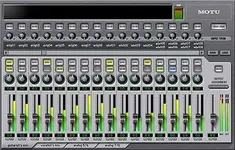Tekker
New member
Hi all,
I’m doing some research into live sound mixing through the computer, because I’d like to try that out in our church. We currently share the building with another church and you know how things go with having several different sound guys at the board.... I'd like to try using the PC so we can have automatic recall for both of our churches. Plus we’d have access to a lot more effects instead of just one reverb/effects unit.
I'd like to try using the PC so we can have automatic recall for both of our churches. Plus we’d have access to a lot more effects instead of just one reverb/effects unit.
We currently have a Mackie 8-bus mixer, but it’s having some issues and we’ll likely have to return it.... If we do I’m going to suggest mixing through the PC instead of trading it in for another of the same mixer.
The biggest thing I’m running into is how to get the sounds into the PC. We’d need at the very least 18 input channels and preferably 24. We will probably only need about 8 outputs (max) for feeding FOH and the stage monitors. What we need for the input interfaces are A/D converters with mic preamps, as all mixing will be done inside the PC. I'm not crazy about using the Behringer ADA8000’s but they seem like the best option. From what I have found, the next step up for A/D’s with mic pres would be in the range of RME which are very expensive for only 8 channels. I even looked at mixers with firewire (like the Mackie Onyx), but they only have 8 preamps. We mic everything, so we will need to have mic pres for each channel. Does Mackie have something like the Behringer ADA8000 that would be a little better quality but not as expensive as RME? I don’t want to sacrifice too much in quality, because we are getting good sounds with the Mackie mixer, but I’m pretty sure we can’t afford 24 channels of RME. I don’t know how much they paid for the Mackie (I’ll have to find out) but I know they got a very good deal on it. So I imagine if they return the mixer, then whatever we do with the PC will have to be in the same price range.
The other stuff I plan on using:
SAWStudio Basic - very low latency and stable, which is perfect for this kind of application.
(2 or 3) Behringer BCF2000 controllers – so the sound guy can control the volume with “real” faders.
Frontier Design Transport (maybe) - for mixing while walking around the room and for letting each musician adjust their own monitor mix from the stage to be just the way they want it (that would be sweet! )
)
Any comments and suggestions on the interface or anything else would be much appreciated.
Thanks,
-tkr
I’m doing some research into live sound mixing through the computer, because I’d like to try that out in our church. We currently share the building with another church and you know how things go with having several different sound guys at the board....
 I'd like to try using the PC so we can have automatic recall for both of our churches. Plus we’d have access to a lot more effects instead of just one reverb/effects unit.
I'd like to try using the PC so we can have automatic recall for both of our churches. Plus we’d have access to a lot more effects instead of just one reverb/effects unit.We currently have a Mackie 8-bus mixer, but it’s having some issues and we’ll likely have to return it.... If we do I’m going to suggest mixing through the PC instead of trading it in for another of the same mixer.
The biggest thing I’m running into is how to get the sounds into the PC. We’d need at the very least 18 input channels and preferably 24. We will probably only need about 8 outputs (max) for feeding FOH and the stage monitors. What we need for the input interfaces are A/D converters with mic preamps, as all mixing will be done inside the PC. I'm not crazy about using the Behringer ADA8000’s but they seem like the best option. From what I have found, the next step up for A/D’s with mic pres would be in the range of RME which are very expensive for only 8 channels. I even looked at mixers with firewire (like the Mackie Onyx), but they only have 8 preamps. We mic everything, so we will need to have mic pres for each channel. Does Mackie have something like the Behringer ADA8000 that would be a little better quality but not as expensive as RME? I don’t want to sacrifice too much in quality, because we are getting good sounds with the Mackie mixer, but I’m pretty sure we can’t afford 24 channels of RME. I don’t know how much they paid for the Mackie (I’ll have to find out) but I know they got a very good deal on it. So I imagine if they return the mixer, then whatever we do with the PC will have to be in the same price range.
The other stuff I plan on using:
SAWStudio Basic - very low latency and stable, which is perfect for this kind of application.
(2 or 3) Behringer BCF2000 controllers – so the sound guy can control the volume with “real” faders.
Frontier Design Transport (maybe) - for mixing while walking around the room and for letting each musician adjust their own monitor mix from the stage to be just the way they want it (that would be sweet!
 )
)Any comments and suggestions on the interface or anything else would be much appreciated.
Thanks,
-tkr

 So I think we'll just trade the mixer back in.
So I think we'll just trade the mixer back in.



